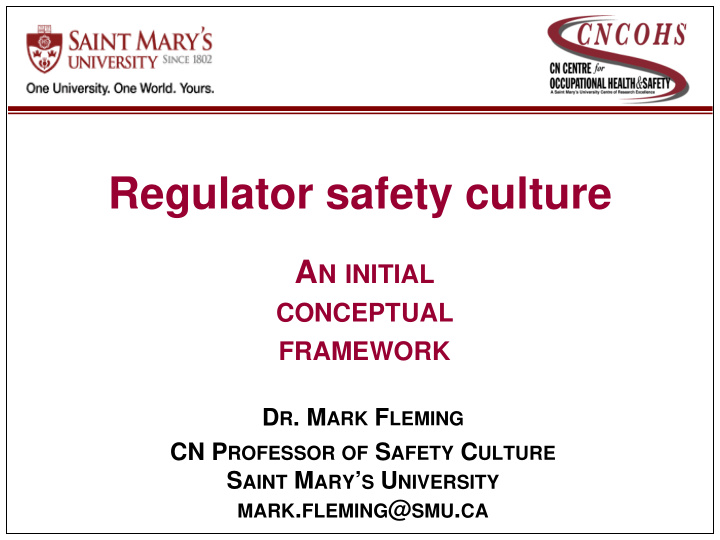



V1.2 Regulator safety culture A N INITIAL CONCEPTUAL FRAMEWORK D R . M ARK F LEMING CN P ROFESSOR OF S AFETY C ULTURE S AINT M ARY ’ S U NIVERSITY MARK . FLEMING @ SMU . CA
V1.2 Outline Background Method: – Literature review – Interviews with safety culture experts Conceptual framework IAEA questionnaire Next steps
V1.2 Background A number of disasters inquiries have identified regulatory failures: – Piper Alpha – Fukushima Daiichi “in order to ensure effective regulatory oversight of the safety of nuclear installations, it is essential that the regulatory body is independent and possesses legal authority, technical competence and a strong safety culture” (p. 7)
V1.2 Literature Very little empirical research Reiman and Norros (2002) investigated the culture of the Finnish nuclear regulator. NEA published a ‘Green book’ guide on regulator safety culture in 2016
V1.2 Expert interviews Interviewed 13 safety culture experts: – Academics – Regulators with responsibility for safety culture – Consultants Interview focused on: – Utility, name and definition – Main dimensions – Assessment
V1.2 Utility, Name and Definition All interviewees agree that the construct was important Less agreement about the name for the term with many preferring the regulatory culture Wide range of definitions which mirrored the range of definitions of safety culture
V1.2 Definition “…that assembly of characteristics and attitudes in organizations and individuals which establishes that, as an overriding priority, protection and safety issues receive the attention warranted by their significance” (IAEA 2007) This definition is also the one adopted by the NEA
Government Industry Safety Culture Industry Association Regulator Duty Holder Duty Holder Safety Safety Culture Safety Culture Culture
V1.2 Leadership “good management is the key to everything […] good management is key to having a good culture […] good management in terms of making sure that people are not overworked and not put under enormous amounts of pressure for the kind of things they have to do… That they have deadlines that are actually manageable, that their managers make decisions and help out.”
V1.2 Proactive, risk informed, flexible “…the primary is the understanding of the nature of risk of the industry that they are regulating.” “on the one hand there is the mutual respect and partnership philosophy and on the other hand there’s the policeman philosophy.” “…I think that good regulators […] spend as much time doing off the record stuff as they do on the record stuff.”
V1.2 Continuous learning “so you’ve got cognitive competence, which is the knowledge. You’ve got the functional competence which is the skill set or the ability enact the knowledge in physical terms… but then you’ve got the wider organizational culture that has you set up to be able to give you the means to display that, and to keep up to date. So educational opportunities, systems that support what you’re asking people to do.”
V1.2 Transparency “…the regulator now that some intolerance of let’s say risks or perceived risks, this is rapidly become an exercise of PR and it shifts the message into everything you say: everything is safe, everything is safe, without having the capacity to say yes, it is safe, they’ve been operating safely however, they need to fix A, B, C and D because they are having issues and struggles here and there. We are at that place now where we are caught between a rock and the hard place and that is becoming a systemic issue and it’s a capacity to report issues of performance in transparent manner without jumping the guns to the necessity of closing the plant.”
V1.2 Ethical standards “how to think of the national nuclear infrastructure and how things [such as political pressure] are influencing each other in ways, in intended ways but very often in unintended ways and dynamic ways that is hard to foresee […] and that is also difficult to formalize to have lots of people thinking of that and talking to each other.”
V1.2 Assessment General agreement that a multi method approach was required Need for the development of assessment tools NEA released a ‘green book’ on regulator safety cuture IAEA decided to develop a regulator safety culture perception survey
V1.2 IAEA questionnaire IAEA consultancy meeting held in Vienna in 2016 to develop draft questionnaire A wide range of experts were involved: – individuals familiar with the NEA document – Experts in questionnaire design – Regulators SMU coordinated questionnaire evalution
V1.2 Developing items Themes Questionnaire dimensions Leadership commitment to creating a Leadership positive safety culture Responsibility and accountability Independence of the regulator Proactive, risk informed and flexible Systemic regulatory approach approach Decision making Continuous learning and self- Continuous learning, improvement and competence improvement Questioning attitude Unwavering ethical standards Ethics and moral courage Psychological safety Transparency through Openness, transparency, external cooperation and communication communication Inter-disciplinary internal cooperation
V1.2 Development and testing Expert group developed items for each dimension and reviewed items Expert group produced 144 item questionnaire Questionnaire reviewed by separate group of 14 experts to reduce number of items – Clarity, relevance, importance Questionnaire reviewed by 18 regulator employees – Importance of items for safety culture Questionnaire reduced to 71 items
V1.2 Next steps Evaluate the psychometric properties of the questionnaire by surveying a sample of English speaking regulator employees Conduct a number of regulator safety culture assessment to develop and test assessment process.
Recommend
More recommend